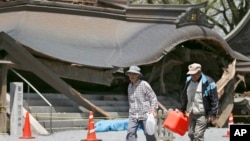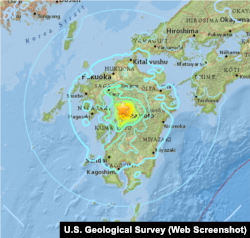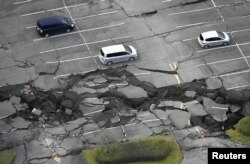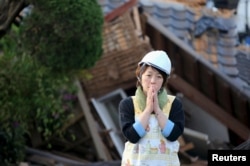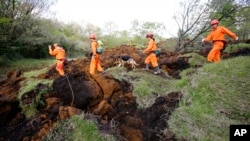Four U.S. Marine Corps V-22 Osprey tilt-rotor aircraft took off from Okinawa Sunday as American forces in Japan joined the earthquake recovery effort in the southern part of the country.
“We are working closely with the government of Japan to provide assistance and support. To the people of Japan and the region affected by this tragedy we send our heartfelt sympathies,” said Air Force Lt. Gen. John Dolan, commander of U.S. Forces Japan, in a statement, which did not provide any further details on the scope of the military assistance being provided.
The United States had offered support for airlift operations and the Defense Ministry in Tokyo is coordinating with USFJ to implement as soon as ready, Kenko Sone, Prime Minister Shinzo Abe’s director of global communications, told VOA.
Aiding in rescue
Abe on Sunday boosted to 25,000 the number of Self Defense Force troops aiding in the rescue and recovery on the main southern island of Kyushu.
Strong aftershocks continue to rattle Kumamoto Prefecture (state) as rescuers confront harsh weather conditions in a race to rescue dozens of people believed still trapped or buried under collapsed buildings.
At least 41 people have died, 11 are reported missing – feared buried by landslides or trapped below rubble – and more than 800 have been injured since Thursday as a result of the strongest tremors, according to Japanese government officials and domestic media reports.
A magnitude-6.5 quake on Thursday, seen as a foreshock to the 7.3 tremor early Saturday, collapsed buildings and bridges, triggered fires and landslides and even derailed a bullet train.
Both quakes were at shallow depths, onshore and located under populated areas.
Full scope of tragedy
Some small communities remain cut off and officials say thus they do not yet know the full scope of the tragedy.
The deadly quakes have sent approximately 200,000 people to school gymnasiums, local government buildings and hotel lobbies due to damage and amid fears of further destructive tremors, according to officials in Kumamoto Prefecture.
The central government is making available 900,000 meals, one ton of baby formula and 60,000 diapers for children, said Taro Kono, the Cabinet minister in charge of disaster response.
Abe had planned to visit Kumamoto, 1,200 kilometers southwest of the capital, to survey the damage, but has decided to avoid the area while aftershocks continue.
Aftershocks
More than 450 detectable tremors, located in or near the Beppu-Shimabara rift zone, which consists of multiple active faults, have been reported since Thursday's earthquake.
Seismologists differ in opinion as to whether the series of quakes could trigger strong tremors in other regions of Japan.
Gen Aoki, director of the Japan Meteorological Agency’s Earthquake and Tsunami Observations Division, raised the possibility that Saturday’s powerful tremor has triggered seismic activity in surrounding areas.
Most seismologists agree, however, that potentially dangerous aftershocks will continue in southern Japan for more than a week.
Scheduled passenger service is expected to resume Monday at Kumamoto Airport, located in Mashiki, the city of 32,000 hardest hit by the quakes.
Other transportation in the region also remains disrupted due to passenger train lines halting service and damaged highways.
Shrine damaged
The historic Aso Shrine, more than 1,700 years old, suffered a great deal of damage. Part of a wall at the 400-year-old Kumamoto castle also collapsed.
About 60,000 homes in Kumamoto Prefecture remained without electricity Sunday evening and water service is still disrupted to 300,000 households, according to the Japanese government, forcing residents to haul water from local offices to their homes.
There have been no reported abnormalities at three nearby nuclear facilities, a government spokesman said.
Operations at key manufacturing plants in the area, including those operated by Toyota, Nissan and Sony, have been disrupted by the quakes.
A number of major companies have located factories in the region because it had been thought to be less prone to destructive earthquakes than other areas of Japan.




